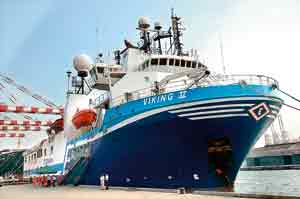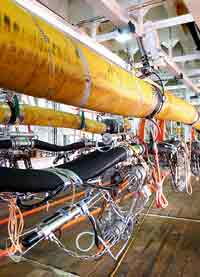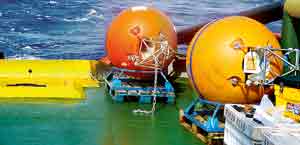With the completion of acquiring three-dimensional (3D) seismic data on 1,750 square km Mannar basin, and finalizing the launching of oil in July this year, Sri Lanka will be offering new oil exploration blocks in an area off the northern coast.
 In an interview with the Business Times, Dr .Neil De Silva, Director-General of the Petroleum Resources Development Secretariat (PRDS) said it was planning to call bids for blocks in 15,000 sq km of the shallow Cauvery Basin, just off the northern area once controlled by the LTTE until their defeat in may 2009. Cauvery Basin oil exploration is in the planning stage of the bidding round to issue exploration license. In an interview with the Business Times, Dr .Neil De Silva, Director-General of the Petroleum Resources Development Secretariat (PRDS) said it was planning to call bids for blocks in 15,000 sq km of the shallow Cauvery Basin, just off the northern area once controlled by the LTTE until their defeat in may 2009. Cauvery Basin oil exploration is in the planning stage of the bidding round to issue exploration license.
He said the gathering of meteorological data and monitoring ocean currents is now underway ahead of a test drilling programme. Dr. De Silva, an expert in petroleum geology and petroleum geo physics acquired experience in the field for over 30 years. He completed his MSc and Phd in Canada and has been involved in onshore oil exploration in Canada and off-shore oil exploration in the Gulf of Mexico.
The Sri Lankan government has signed a Petroleum Resources Agreement in 2008 with Cairn India to explore and produce hydro - carbon and natural gas in the Mannar Basin in Northern Sri Lanka.
In accordance with the agreement, Cairn Lanka, a subsidiary of Cairn India Ltd has commenced its exploration activities in Block SL2007/01/001 in the Mannar basin which covers 3400 square km, at depths between 200 to1,800 meters. The total estimated cost of oil exploration in the Mannar Basin is $172 million. The project has spent $17.5 million up to September 30, 2010. The estimated cost of drilling five oil exploration wells in the Mannar Basin is $120 million. The Mannar area is estimated to have deposits of one billion barrels of oil.
 Outlining the financial benefits for the country, if Sri Lanka's quest for oil becomes a reality, Dr. De Silva noted that the oil production share will be divided between the government of Sri Lanka and Cairn Lanka and it is to be calculated by Investment Multiple (M) which is the ratio of accumulated Net Cash Income to accumulated investment as defined in the Petroleum Resources Agreement. At the inception of the oil production process the Sri Lankan government's share would be 15% and Cairn Lanka 85%, he revealed. The Sri Lankan government will also receive a 10 % royalty, a $50 million production bonus, the profit share based on the investment, a 15 % tax on 'contractor profit' and other taxes. Outlining the financial benefits for the country, if Sri Lanka's quest for oil becomes a reality, Dr. De Silva noted that the oil production share will be divided between the government of Sri Lanka and Cairn Lanka and it is to be calculated by Investment Multiple (M) which is the ratio of accumulated Net Cash Income to accumulated investment as defined in the Petroleum Resources Agreement. At the inception of the oil production process the Sri Lankan government's share would be 15% and Cairn Lanka 85%, he revealed. The Sri Lankan government will also receive a 10 % royalty, a $50 million production bonus, the profit share based on the investment, a 15 % tax on 'contractor profit' and other taxes.
The exploration license is deemed to be valid for eight years and divided into three stages of three, two and three years. As the years go by Sri Lanka's share will be increased to 17.5%, 20%, 40%, 60% and 85% and Cairn Lanka's share will come down to 82.5%, 80%, 60%, 40% and 15%, respectively. He said that every aspect of the oil exploration deal is fully transparent and all the details have been made available to general public both here and overseas through the PRDS web site.
Explaining the history of the country's oil exploration efforts, Dr. De Silva noted that petroleum exploration in Sri Lanka began approximately 40 years ago in the late 1960s. In 1967-68, French firm Compaigne General de Geophysicque collected approximately 420 km of onshore and 75 km of offshore seismic data on behalf of the Ceylon Petroleum Corporation (CPC or Ceypetco).
The Soviets, with their increased interest in South Asia in the 1970s, recorded 4837 km of marine seismic data in 1972 to 1975 along with some onshore data to evaluate the Palk Bay area in the Cauvery Basin under an agreement with the Sri Lankan government. In 1974 Soviets 'spudded (gave up)' Pesalai 1 on the Mannar Island and drilled to 'a TD of 2594 metres to pre-Cambrian gneiss basement', according to documents. The well encountered a water-bearing basal Lower Cretaceous sandstone with a small amount of dissolved gas with heavy ends to pentane. Encouraged by this in Pesalai 1, the Soviets drilled two more wells nearby -- Pesalai 2 and Pesalai 3, but both failed to encounter significant reservoir rocks or a trap. This led to the withdrawal of the Soviets from the area.
 In 1975 CPC engaged Pexamin Pacific as a consultant to promote exploration in the Sri Lankan portion of the Cauvery Basin. In 1976 Western Geophysical recorded 1947 km of 2D seismic data around the island. Western Geophysical also collected 2829 km of seismic data in the Palk Strait and the Gulf of Mannar in 1976. Subsequently, Pexamin Pacific signed a contract with CPC for an offshore exploration block. Marathon Petroleum farmed into Pexamin's interest in 1976 and drilled two exploratory wells, Palk Bay-1 and Delft-1 in the Cauvery Basin, both targeting 'horst block plays'. Both failed to encounter any hydrocarbons and in 1977, the Marathon -Pexamin group relinquished its interests. In 1975 CPC engaged Pexamin Pacific as a consultant to promote exploration in the Sri Lankan portion of the Cauvery Basin. In 1976 Western Geophysical recorded 1947 km of 2D seismic data around the island. Western Geophysical also collected 2829 km of seismic data in the Palk Strait and the Gulf of Mannar in 1976. Subsequently, Pexamin Pacific signed a contract with CPC for an offshore exploration block. Marathon Petroleum farmed into Pexamin's interest in 1976 and drilled two exploratory wells, Palk Bay-1 and Delft-1 in the Cauvery Basin, both targeting 'horst block plays'. Both failed to encounter any hydrocarbons and in 1977, the Marathon -Pexamin group relinquished its interests.
In 1981, Cities Services acquired interests in the Cauvery and the Mannar basins and collected a total of 1556 km of seismic, 1289 km in the Gulf of Mannar and 267 km in Palk Bay. The same year Cities Services drilled Pearl-1, located on the northeast shelf of the Gulf of Mannar. This well was drilled to a total depth of 3050 m with no oil and gas shows. The well bottomed in a volcanic sill and is the only well on the Sri Lankan portion of the Mannar Basin to date. On the positive side, the well penetrated an 850 m thick Late Cretaceous basal sandstone unit thereby establishing the presence of significant reservoir rocks in the Mannar Basin, according to documents.
In 1984 under a tripartite agreement between Phoenix Canada Oil Company, Petro-Canada and CPC, Petro-Canada acquired 980 km of 2D seismic data in the Mannar Basin. This is the first comprehensive seismic programme in the Mannar Basin. However, no further work was done and by 1984 petroleum exploration work in offshore Sri Lanka came to a halt and remained dormant till 2001.
In 2001 under a contract from the Asian Development Bank to evaluate the petroleum potential of Sri Lanka as well as its petroleum administrative and fiscal regime, the University of New South Wales (Newsouth Global Pty Ltd) provided an interpretation report and draft petroleum legislation and a Petroleum Resources Agreement. The latter was coined after the Indian Production sharing Contract (PSC) at that time. Encouraged by the report of the Newsouth Global, TGS NOPEC, a Norwegian seismic contractor with a regional office in Perth, Australia, approached CPC to undertake a speculative seismic program in the Mannar Basin, according to documents.
In 2001 CPC and TGS NOPEC signed an agreement to collect 1100 km of 2D seismic data in the Mannar Basin. The data was acquired in June-July 2001 and a detailed interpretation report was produced by Newsouth Global in 2002 (Newsouth Global 2002) under contract to TGS NOPEC. The report highlighted the petroleum potential of the Mannar Basin and encouraged TGS NOPEC to collect additional 4600 km of seismic in the basin 2005. These two TGS NOPEC data acquisitions provide a modern, high quality 2D seismic data set in the Mannar Basin for exploration companies interested in the area.
In 2007 September the Petroleum Resources Development Secretariat under the Ministry of Petroleum and Petroleum Resources Development launched the Mannar Basin Licensing Round for three exploration blocks in the Mannar Basin. An extensive marketing campaign was carried out globally with roadshows and data rooms in London, Houston and Kuala Lumpur. On July 7, 2008 the Government of Sri Lanka, through the Minister of Petroleum and Petroleum Resources Development signed a Petroleum Resources Agreement with Cairn Lanka (Private) Limited marking the beginning of petroleum exploration of Sri Lanka after a hiatus of 25 years.
|

 In an interview with the Business Times, Dr .Neil De Silva, Director-General of the Petroleum Resources Development Secretariat (PRDS) said it was planning to call bids for blocks in 15,000 sq km of the shallow Cauvery Basin, just off the northern area once controlled by the LTTE until their defeat in may 2009. Cauvery Basin oil exploration is in the planning stage of the bidding round to issue exploration license.
In an interview with the Business Times, Dr .Neil De Silva, Director-General of the Petroleum Resources Development Secretariat (PRDS) said it was planning to call bids for blocks in 15,000 sq km of the shallow Cauvery Basin, just off the northern area once controlled by the LTTE until their defeat in may 2009. Cauvery Basin oil exploration is in the planning stage of the bidding round to issue exploration license.  Outlining the financial benefits for the country, if Sri Lanka's quest for oil becomes a reality, Dr. De Silva noted that the oil production share will be divided between the government of Sri Lanka and Cairn Lanka and it is to be calculated by Investment Multiple (M) which is the ratio of accumulated Net Cash Income to accumulated investment as defined in the Petroleum Resources Agreement. At the inception of the oil production process the Sri Lankan government's share would be 15% and Cairn Lanka 85%, he revealed. The Sri Lankan government will also receive a 10 % royalty, a $50 million production bonus, the profit share based on the investment, a 15 % tax on 'contractor profit' and other taxes.
Outlining the financial benefits for the country, if Sri Lanka's quest for oil becomes a reality, Dr. De Silva noted that the oil production share will be divided between the government of Sri Lanka and Cairn Lanka and it is to be calculated by Investment Multiple (M) which is the ratio of accumulated Net Cash Income to accumulated investment as defined in the Petroleum Resources Agreement. At the inception of the oil production process the Sri Lankan government's share would be 15% and Cairn Lanka 85%, he revealed. The Sri Lankan government will also receive a 10 % royalty, a $50 million production bonus, the profit share based on the investment, a 15 % tax on 'contractor profit' and other taxes.  In 1975 CPC engaged Pexamin Pacific as a consultant to promote exploration in the Sri Lankan portion of the Cauvery Basin. In 1976 Western Geophysical recorded 1947 km of 2D seismic data around the island. Western Geophysical also collected 2829 km of seismic data in the Palk Strait and the Gulf of Mannar in 1976. Subsequently, Pexamin Pacific signed a contract with CPC for an offshore exploration block. Marathon Petroleum farmed into Pexamin's interest in 1976 and drilled two exploratory wells, Palk Bay-1 and Delft-1 in the Cauvery Basin, both targeting 'horst block plays'. Both failed to encounter any hydrocarbons and in 1977, the Marathon -Pexamin group relinquished its interests.
In 1975 CPC engaged Pexamin Pacific as a consultant to promote exploration in the Sri Lankan portion of the Cauvery Basin. In 1976 Western Geophysical recorded 1947 km of 2D seismic data around the island. Western Geophysical also collected 2829 km of seismic data in the Palk Strait and the Gulf of Mannar in 1976. Subsequently, Pexamin Pacific signed a contract with CPC for an offshore exploration block. Marathon Petroleum farmed into Pexamin's interest in 1976 and drilled two exploratory wells, Palk Bay-1 and Delft-1 in the Cauvery Basin, both targeting 'horst block plays'. Both failed to encounter any hydrocarbons and in 1977, the Marathon -Pexamin group relinquished its interests. 